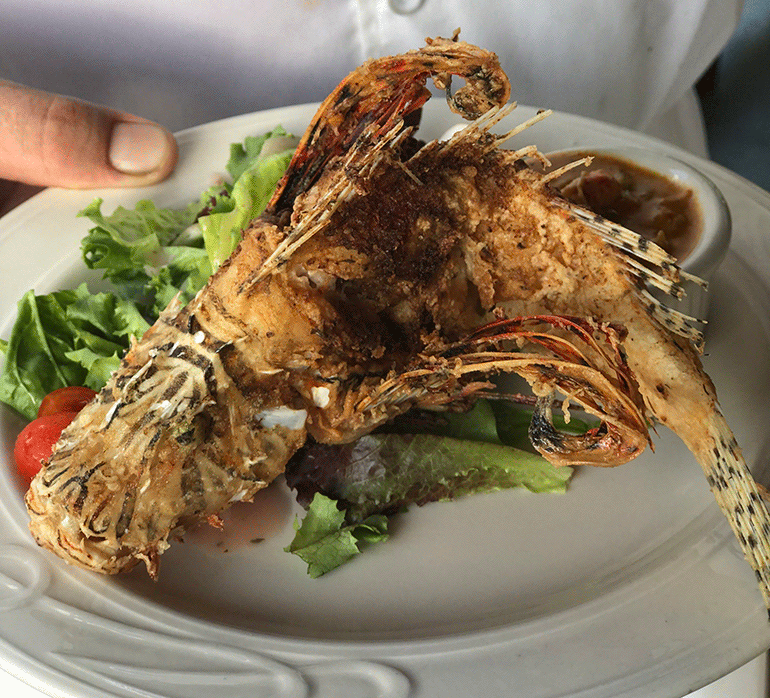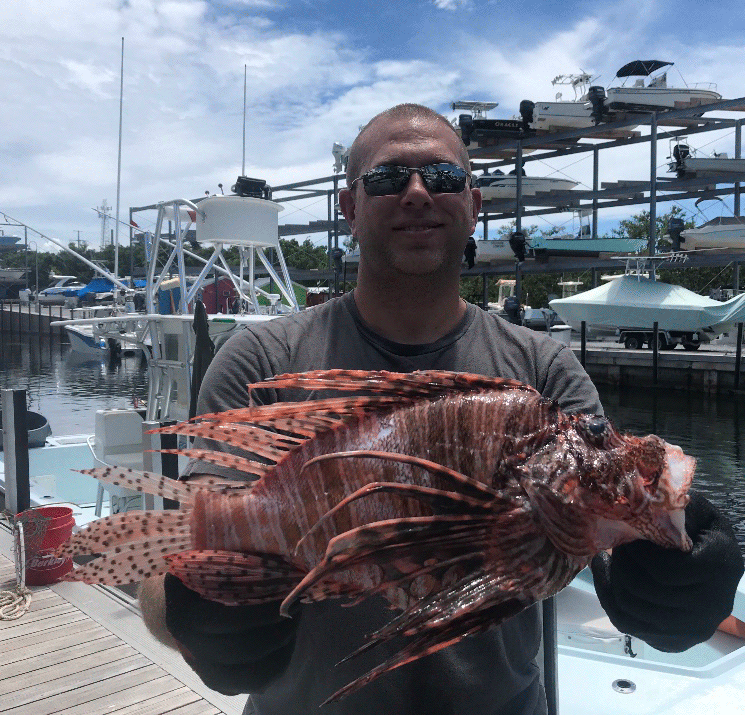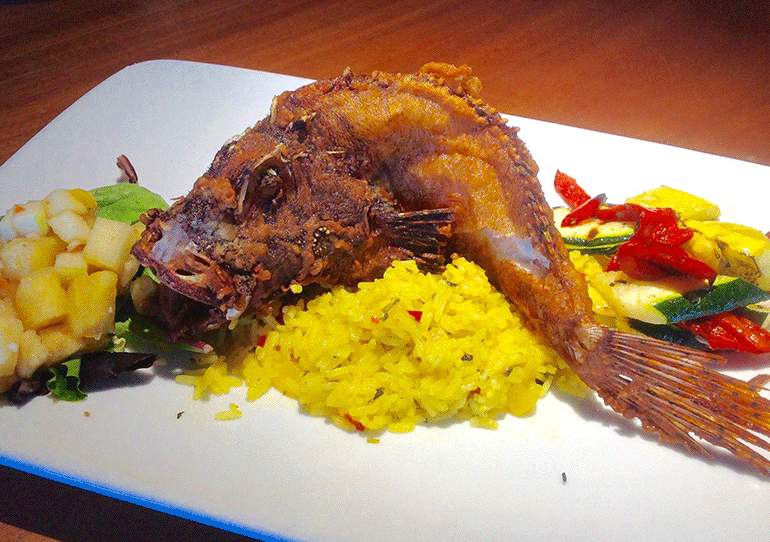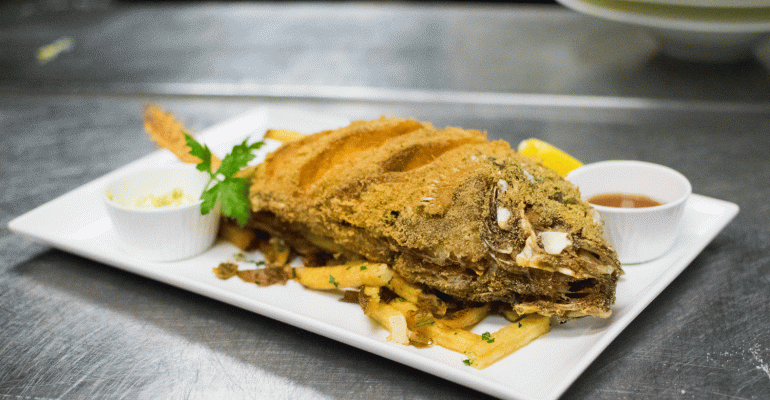Lionfish may have no predators in the Atlantic and Caribbean, where the United States Department of Agriculture considers it an invasive species, but the ornamental fish that is native to coral reefs in the South Pacific and Indian Oceans should watch out for chefs who are increasingly out to eradicate it by plating it.
“Our menu is built around the idea of changing the species all the time, sometimes on a daily basis,” said Andrew Gruel of Huntington Beach, Calif.-based Slapfish Restaurant Group. “Our motto is ‘choose the dish, not the fish’ meaning, we want people to try new fish all the time in an effort to get people to eat more underutilized, and in many cases invasive, species.”
Slapfish first served lionfish last May at its Albuquerque, N.M., location.
“We did tacos and fritters,” said Gruel. “People loved it.”

Flash fried whole fried lionfish at Chef Michael’s.
People were also talking about it on Instagram after the franchise owner posted a photo of the white-skinned fish with red vertical stripes and a spiked mane on Instagram. What followed was a robust conversation among Slapfish followers about lionfish’s taste, flavor, where to get it, and more.
Diners at The Depot in Auburn, Ala, are also big fans of lionfish, thanks to executive chef Scott Simpson, who first discovered the invasive species while working as a chef in Montego Bay, Jamaica.
“Because we have earned our guests’ trust, these adventurous or more exotic offerings seem to do exceptionally well,” said Simpson. “Frankly, I buy all I can when it’s available because I know it sells out.”
Simpson offers lionfish in all manner of preps, from fish and chips with lemon caper gremolata tartar sauce, sea salt horseradish fries, and malt vinegar to seared fillet with a Veracruz-style tomato olive caper sauce.
People weren’t nearly as eager to try lionfish eight years ago when Michael Ledwith started serving it at Chef Michael’s, his 50-seat restaurant in Islamorada, Fla. Part of diners’ reservations, he said, was that they mistakenly perceived lionfish as poisonous. In reality, lionfish has a venomous, not poisonous, spine. The venom has to be injected into the bloodstream to be harmful; it can’t just be eaten. Besides, lionfish meat has no venom in it, so it’s completely safe to eat after careful removal of the spine.

Fisherman Timothy Blasko with a Florida State record lionfish he speared.
To educate and entice diners to eat lionfish, Ledwith began frying up sample bites and circulating them around the dining room.
“We’d sample people and they’d be hooked,” said Ledwith. “It’s really popular now.”
Currently, diners can order whole lionfish Cuban style, marinated in Key lime juice and Cuban oregano and then flash fried; or lionfish fillets crusted in macadamia nuts, cashews and pistachios and served with a mango sauce.
Lionfish is so abundant in the region, and now so popular at Chef Michael’s, that Ledwith recently bought a Cryovac machine and installed a dedicated walk-in freezer to store overflow harvest so he can serve it even in the off-season.
Although Andrea Pitera, owner of Mojo’s on the Harbor in Bald Head Island, N.C., loves lionfish and has served it tempura fried, in ceviches or raw as sushi, lately she’s had trouble sourcing it.
“It was exquisitely delicious,” Pitera said. “What’s happened is more and more restaurants in areas where lionfish are prevalent are serving it.”

While fried lionfish at Mojo’s on the Harbor in Bald Head Island, NC.
She last served lionfish a year ago before her local sources dried up. If she had a new source, Pitera says she’d put lionfish on her menu again “in a heartbeat.”
Pitera, and others like her, may now be in luck.
Three years ago chef, restaurateur and entrepreneur Ryan Chadwick launched Norman’s Lionfish, a lionfish fishery, to help prevent this “vacuum cleaner of the sea” from devastating our oceans by supplying restaurateurs with this delicious, versatile fish.
“I see a lot of chefs wanting to work with the fish, which is exactly what we want,” said Chadwick.
He first served lionfish at Norman's Cay, his now-closed Caribbean-style seafood restaurant on New York City’s Lower East Side. No matter how he served it, he says it was a customer favorite. That experience convinced him that if he could create commercial demand for lionfish as food, he could help solve the problem of its overabundance.
When Chadwick started Norman’s Lionfish it was just him and a single fisherman bringing in about 40 pounds of lionfish a week. Now, he employs a network of local fisherman who bring in about 800 pounds to 1,000 pounds of lionfish per week which is then sold in retail and to his more than 20 wholesale clients, which include restaurants, schools and other foodservice operators across the country. Chadwick also serves lionfish as a special at his three Grey Lady seafood restaurants in Aspen, Colo.; Montauk, N.Y.; and New York City.
Demand for this prickly fish is likely to continue to grow now that chefs’ and diners’ interests are piqued and as more suppliers emerge.
For example, Kyle Raymond, who was first introduced to lionfish while he was the executive chef of Chadwick’s Grey Lady Aspen, recently opened Roosters, an American rotisserie in nearby Carbondale, Colo., where he plans to offer the fish for upcoming specials.
“It lends itself to sauces. It’s very versatile,” said Raymond. “I’ll definitely bring it in for specials.”
And while lionfish has largely been showing up on menus of chef-driven independents or small chain menus, it may soon infiltrate menus of major chains as well.
“A national chain is starting to work with lionfish now,” said Chadwick of a recent client he preferred not to call by name. “They’ve been testing it.”





